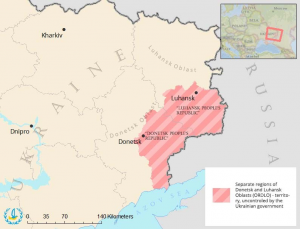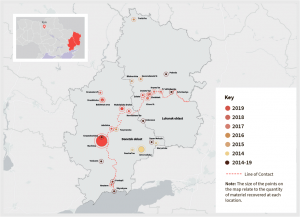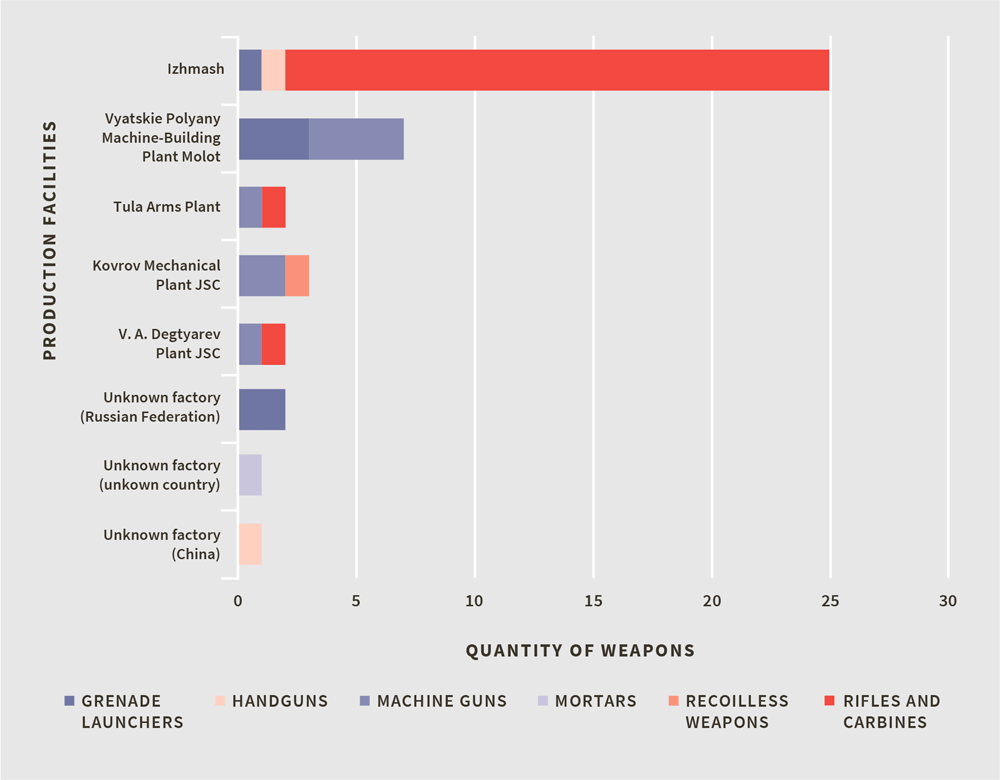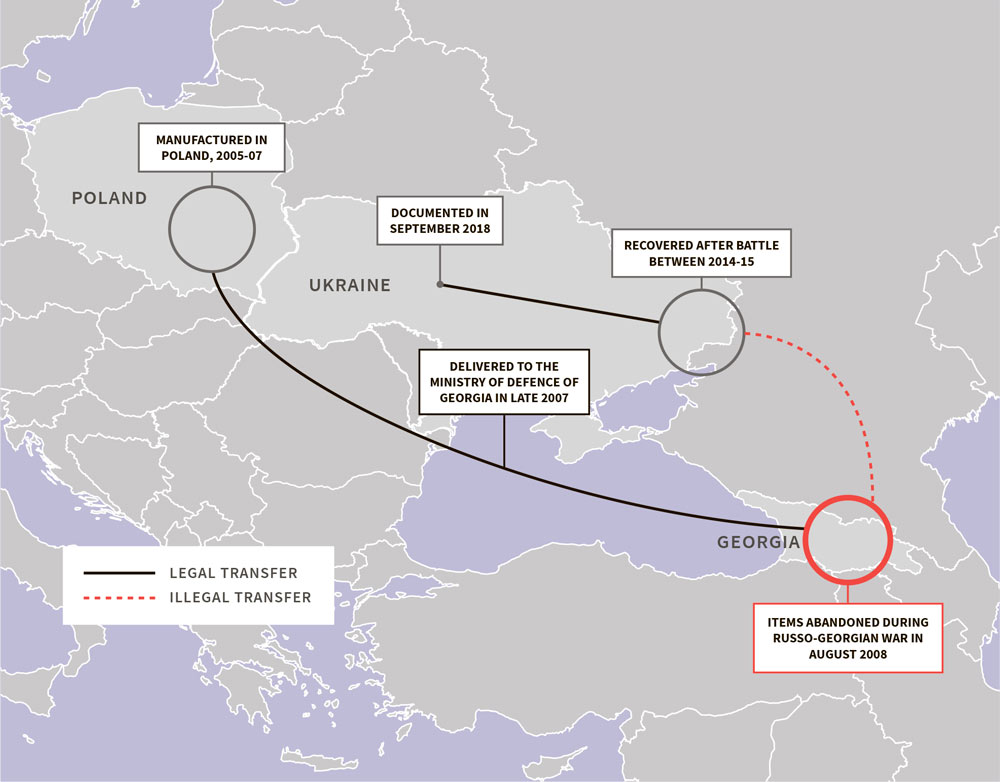
CAR tracks the supply of weapons and ammunition into conflict-affected areas. Previously, CAR investigated the sources of military supplies into Iraq, Syria, Yemen, Sudan, Mali, Central African Republic.
Since 2018, CAR field investigation teams have carried out forensic documentation of the military equipment that has been recovered from armed formations of the self-declared Donetsk and Luhansk "People's Republics" (DNR and LNR, or LDNR collectively) in eastern Ukraine, officially known as certain areas of the Donetsk and Luhansk oblasts or ORDLO.
This report is the result of a three-year study into the supply sources of weapons, ammunition, vehicles, armor, and artillery used in the conflict.
"This report is a window into a largely forgotten conflict that, since early 2014, has persisted at the edge of Europe," the study reads.
Here are five major finds of the report.
Most of the LDNR weapons are made in Russia

Unsurprisingly, the study shows that most of the examined weapons and material had Russian origins: the majority of the 4,793 small-caliber ammunition studied by CAR in Ukraine and all but two of the 43 weapons, or 95%, were manufactured in the territory of the Russian Federation.
personnel carriers, and truck tractors.
Multiple earlier studies largely based on the analysis of open-source photo and video evidence rather than systematic field-based investigations have already proved the extensive use of Russian weapons and matériel in the ORDLO.
CAR, however, uses digital evidence only occasionally as background information and doesn't base its investigations on it. Instead, CAR analyses physical evidence gathered from the weapons themselves. The organization's field investigators document the items of weapons, ammunition, matériel recovered in the conflict zones by government forces, surrendered, cached, or held by insurgent forces.

Having access to hard evidence in the field, the investigators take photographs of items including external and internal markings on them -- something, as the study points, often missing in open-source information. The further documentation of the item includes fixing the date, geo-data, incorporating contextual interviews with those in control of the items at the time of documentation.
The next step of the investigation is tracing the traceable items to the source of their origin, using a variety of government, commercial, transport, and other documents.

CAR found that a significant proportion of the examined items recovered from LDNR were manufactured after the collapse of the USSR, which means that these weapons and ammunition can't come from Ukraine's Soviet-times stocks.


The study concluded that the conflict in Ukraine isn't dependent on extra-regional supply chains based on the finding that almost half of the weapon models had never been documented by CAR in any of the other conflicts previously investigated by the organization.
CAR also found that most small arms they had documented displayed matching serial numbers on their main components, which is an indication that such parts were original and weren't replaced with components from other weapons.
"The lack of component mixing suggests a short chain of custody between the point at which weapons left a production facility or military inventory and use by armed formations operating in certain areas of the Donetsk and Luhansk oblasts of Ukraine," the report reads.
Obliterated markings
In 2014, the Russian-hybrid forces used to overpaint the original Russian markings on military vehicles to hide their true origin. It appears, that they did it not only to the heavy equipment: the CAR investigation exposes the systematic obliteration of certain marks on specific types of ammunition.
According to the report, the investigators observed obliterated identifying marks in "about two-thirds of the RPO-A and all of the MRO-A disposable rocket launchers" they had documented in Ukraine. Both types of ammunition are produced only in Russia.
"As with all cases of obliteration, it is likely that parties removed the marks either to conceal evidence of the precise point of diversion or to mask the country of manufacture," the report reads.
Interestingly, those who obliterated some marks on the launchers knowingly left others untouched, which allows maintaining weapon inventories even with primary identifying marks removed.
"This method suggests that the suppliers and the end users of these weapons applied recordkeeping and inventory management processes in line with established military doctrine, implying that they operated within a larger, centralised logistics structure."

Moreover, the investigators found that the manner of removing the identifying markings wasn't consistent, which suggests that these items were supplied via different channels while it was up to the end-users how to get rid of the marks.
Polish MANPADS
Some items examined by CAR weren't manufactured in Russia, however, by came to ORDLO from Russia together with other army supplies. For example, Russian forces stole Polish-made GROM E2 MANPADS in Georgia in 2008, and in 2014 these portable surface-to-air missiles popped up in the warzone in the east of Ukraine and were later recovered by the Ukrainian troops.

Russian drones and their components supplied bypassing arms embargo
Among eight inspected unmanned aerial vehicles (UAVs), CAR documented six different models of Russian military UAVs and one model of a civilian drone.
"CAR’s tracing of components of Russian-manufactured UAVs, recovered from armed formations operating in certain areas of the Donetsk and Luhansk regions of Ukraine, identified independent Russian electronics and component distributors as conduits for foreign technology acquisition on behalf of Russian defense and security entities," the report reads.
One of the documented UAV models was a recovered intelligence, surveillance, and reconnaissance military drone, which happened to be the same model as one recovered in Lithuania in 2016, where Russia users UAVs for illegal intelligence.
"Both UAVs had been constructed using a range of components manufactured in EU states," according to the report.

Most of the EU-manufactured components were produced and supplied before the EU, EU, and other world powers started imposing sanctions against Russia after to the beginning of the Russo-Ukrainian war in 2014. However, some of the EU-made components were shipped to Russia when it already was under sanctions,
"...between 2014 and 2018, according to Russian customs records, Israel Aerospace Industries (IAI) supplied a sanctioned Russian defense company and its subsidiary with UAV components produced by a range of European and US manufacturers," the report reads.

"Disagreements between European governments and industry actors pose challenges to the enforcement of embargoes. Opaque licensing requirements for dual-use components, combined with a lack of clarity over the ultimate end-use or end-user of components, appear to facilitate the integration of key EU-made technology into Russian military UAVs, despite an EU arms embargo that was imposed on the Russian Federation in 2014," the report authors believe.
- Read also: How German companies violated sanctions to bring Dutch sea platform to luxury marina in Crimea
Military and dual-use production in ORDLO
CAR has provided evidence of attempts to restart the production of ammunition at PJSC
Luhansk Cartridge Works for supplying the "LNR" armed formations, and, according to the report, "these efforts involved private Russian entities."
Having analyzed Russian trade records, CAR also identified five other manufacturers in ORDLO specialized in producing defense and dual-use goods, which made exports to Russia past-2014,
| Factory | Part of Ukroboronprom? | Under Ukrainian sanctions since August 2014? | Goods exported | Consignee in the Russian Federation |
|---|---|---|---|---|
| ‘Aviatech-Plus’ LLC | No | No | Turbine engine parts | ‘Aviatech’ LLC |
| Donetsk Branch of ‘Aviatech’ LLC | No | No | Engine maintenance tools; parts for aero-engines, including TV3-117VM (for Mil and Kamov helicopters), AI-series (Ivchenko/Motor Sich) turbofan engines, and DI-18T engines (for An-124 and An-225 cargo aircraft) |
Aviatech’ LLC |
| ‘Pervomayskiy Mechanical Plant’ PJSC | Yes | Yes | Wide range of aircraft components, particularly for IL-76 cargo aircraft | JSC ‘Avia-Fed-Service’ (aviation components distributor |
| State Enterprise ‘Luhansk Aircraft Repair Plant’ | Yes | Yes | Pressure instruments, pipes, and tanks originally produced by military–civilian aircraft engine producer Motor Sich (Ukraine) | ‘ASZ’ LLC |
| State Enterprise ‘Yunost’ |
No | Yes | Voltage relays; AC/DC converters | Four large electronic component distributors: • JSC NPP ‘Promelectron’, • JSC ‘TsMK-Aero’, • JSC ‘Hermes’, • JSC ‘NOMINAL’ |
Virtually, all of the Ukrainian state-owned factories and most of the privately-owned ones located in the Russian-occupied areas of Ukraine's east were seized by occupation administrations or armed formations back in 2014 or in the subsequent years, however, Ukraine didn't sanction all of those, as the first two lines of the table show.
"Further investigation is necessary to determine whether illegal expropriation and asset stripping of these Ukrainian state enterprises is occurring in certain areas of the Donetsk and Luhansk regions of Ukraine," the report reads.
Read the full text of CAR's report
Weapons of the War in Ukraine to see the detailed information about many of the documented weapons and pieces of equipment and see more of its findings.
Further reading:
- Ukrainian OSINT sleuths release largest existing database of evidence of Russian aggression in Ukraine
- Echoes of Nagorny Karabakh. Why Germany is worried about Ukraine’s drones in the Donbas war
- Largest-yet report on Ukraine invasion documents Russian army in Donbas
- What Surkov’s hacked emails tell about Russia’s hybrid war against Ukraine
- New footage shows Russian PMC Wagner involved in crucial 2015 Debaltseve battle in Ukraine
- What we know about Russia’s active duty soldiers captured in eastern Ukraine from 2014
- Ex-puppet state leader turned MP admits it is Russian Army fighting in Donbas
- More evidence of Russia’s aggression against Ukraine discovered by digital sleuth as Russia keeps denying its involvement
- Russian aggression, documented: How official documents reveal Russia’s involvement in Ukraine

